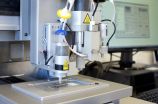(Press-News.org) This news release is available in German.
Ragweed (Ambrosia artemisiifolia) - an otherwise unremarkable plant - produces pollen that can trigger strong allergic reactions such as asthma even in very small quantities. Scientists from Technische Universität München (TUM) and Helmholtz Zentrum München have now published a joint study showing that the substance previously identified as the major allergen only induces such a vigorous allergic response in combination with the adenosine also present in the pollen.
Ragweed only started to become widespread in the last few decades. To date, the major allergen within its pollen was thought to be the protein Amb a 1. This is because the majority of humans that come into contact with ragweed pollen develop antibodies against this protein - one of the body's protective mechanisms against undesirable substances or pathogens. In an allergic reaction, though, these antibodies are produced unnecessarily.
New experimental disease model for allergic symptoms
If ragweed pollen enters the airways, it triggers a strong inflammatory reaction in the lung tissue, which can result in respiratory problems or even asthma. A team led by Prof. Claudia Traidl-Hoffmann, TUM Chair for Environmental Medicine (UNIKA-T), and Prof. Carsten Schmidt-Weber, Director of the Center of Allergy and Environment (ZAUM) - a cooperation between TUM and the Helmholtz Zentrum München - has now investigated these allergic responses for the first time with an experimental disease model they developed. The scientists used this to test how individual components of the pollen affected pulmonary tissue.
Describing the findings, Dr. Maria Wimmer, one of the study's main authors together with Dr. Francesca Alessandrini, explains: "We were able to show that the major allergen Amb a 1 barely triggered inflammation on its own - in contrast to the whole pollen extract, which was highly allergenic."
Pollen-derived adenosine exacerbates allergic reaction
The experimental disease model entailed intranasal instillation of different pollen components over eleven days. The researchers then examined the lungs for signs of inflammation, including the presence of specific immune cells in the tissue. During this study, the whole pollen extract, just the protein Amb a 1 or a protein-free fraction of the pollen extract were applied.
"Contrary to our expectations, only the whole extract produced an allergic reaction. This led us to assume that another substance besides Amb a 1 is responsible for the pollen's effect," reveals Alessandrini. In their efforts to identify a possible candidate, the scientists were aided by one of their own previous studies in which a high concentration of adenosine was detected in birch pollen. "Large amounts of adenosine are also present in ragweed pollen, making this a promising avenue of investigation," adds the researcher.
To test this hypothesis, the scientists removed adenosine from the whole pollen extract and administered the mixture again. Only minimal signs of inflammation were detected as a result. Giving adenosine on its own also triggered no clear allergic reaction in the lungs.
Adenosine receptor antagonists to treat allergic asthma?
Adenosine also occurs naturally in the human body and is involved in many different processes - the surface of almost every cell thus features dedicated recognition molecules. "Exactly how adenosine aggravates allergies is something we have yet to determine. Evidently, though, pollen-derived adenosine binds to the body's own receptors and can trigger allergies in combination with other substances," clarifies Wimmer.
Experimental studies have already demonstrated that adenosine receptor antagonists can aid the treatment of asthma by blocking the body's adenosine receptors. Summarizing upcoming scientific plans, Wimmer concludes: "Since our study shows that adenosine is a decisive factor in ragweed allergy, our next aim is to test whether these substances can relieve or prevent asthmatic symptoms here too."
INFORMATION:
Original publication
M. Wimmer, F. Alessandrini, S. Gilles, U. Frank, S. Oeder, M. Hauser, J. Ring, F. Ferreira, D. Ernst, J. B. Winkler, P. Schmitt-Kopplin, C. Ohnmacht, H. Behrendt, C. Schmidt-Weber, C. Traidl-Hoffmann, J. Gutermuth, Pollen-derived adenosine is a necessary cofactor for ragweed allergy, Allergy, 2015.
DOI: 10.1111/all.12642
http://onlinelibrary.wiley.com/doi/10.1111/all.12642/abstract
Contact
Dr. Maria Wimmer
Scientist, Institute of Environmental Medicine, UNIKA-T
Technische Universität München and Helmholtz Zentrum München
Phone: +49 (89) 3187-3061
E-mail: maria.wimmer@tum.de
Dr. Francesca Alessandrini
Scientist, Center of Allergy and Environment (ZAUM)
Technische Universität München and Helmholtz Zentrum München
Phone: +49 (89) 3187-2524
E-mail: franci@helmholtz-muenchen.de
A group of researchers at Chalmers University of Technology have managed to print and dry three-dimensional objects made entirely by cellulose for the first time with the help of a 3D-bioprinter. They also added carbon nanotubes to create electrically conductive material. The effect is that cellulose and other raw material based on wood will be able to compete with fossil-based plastics and metals in the on-going additive manufacturing revolution, which started with the introduction of the 3D-printer.
3D printing is a form of additive manufacturing that is predicted to ...
Astronomers have long theorised the existence of a first generation of stars -- known as Population III stars -- that were born out of the primordial material from the Big Bang [1]. All the heavier chemical elements -- such as oxygen, nitrogen, carbon and iron, which are essential to life -- were forged in the bellies of stars. This meansthat the first stars must have formed out of the only elements to exist prior to stars: hydrogen, helium and trace amounts of lithium.
These Population III stars would have been enormous -- several hundred or even a thousand times more ...
Scientists have developed a new tissue 'scaffold' technology that could one day enable the engineering of large organs.
Research led by the Universities of Bristol and Liverpool has shown that it is possible to combine cells with a special scaffold to produce living tissue in the laboratory. It is hoped this can then be implanted into patients as a way of replacing diseased parts of the body.
Until now, the approach has generally been limited to growing small pieces of tissue, as larger dimensions reduce the oxygen supply to the cells in the centre.
A team of ...
HOUSTON, June 18 -- Taking research from the lab to the clinic can be a long and arduous process, but necessary to ensure new therapeutic methods are safe. This typically involves models created in the lab to closely resemble the cellular mechanism of the human body.
Researchers at Baylor College of Medicine say they have now created a new disease model that more than just resembles the human mechanisms; it acts as a fully functioning human lipid system within a mouse to specifically study hypercholesterolemia, a form of high cholesterol caused by a genetic defect.
The ...
About a fifth of all U.S. children live in poverty. These children are more likely to experience learning and cognitive delays. Researchers have tried to determine causes for this disparity, with recent work identifying the hormone cortisol as a possible reason because of its ability to pass the blood-brain barrier. Cortisol is one of the most influential hormones in the human body, often referred to as the stress hormone because it's secreted into the bloodstream at higher levels as part of the body's flight-or-fight response. Now a new study has identified how specific ...
Teenagers vary substantially in their ability to control impulses and regulate their behavior. Adolescents who have difficulty with impulse control may be more prone to risky sexual behavior, with serious consequences such as sexually transmitted diseases and unintended pregnancies. A new study has found that individual differences in working memory can predict both early sexual activity and unprotected sexual involvement during adolescence.
Working memory -- the system in the brain that allows individuals to draw on and use information to plan and make decisions -- ...
Migraine researchers and clinicians are growing excited about a new class of drugs called Calcitonin Gene-Related Peptide (CGRP) monoclonal antibodies, which are showing promise in treating high-frequency episodic migraine and chronic migraine.
"This development is a transformative moment in migraine treatment," said Peter J. Goadsby, MD, PhD, who is chair of the scientific program of the American Headache Society's annual Scientific Meeting. Dr. Goadbsy is Chief of the UCSF Headache Center, and one of the world's leading headache treatment experts and researchers. ...
So perhaps there is some truth in the old legends of the underworld reeking of brimstone (or sulphur, as it is now called)? New research confirms that the Earth's core does in fact contain vast amounts of sulphur, estimated to be up to 8.5 x 1018 tonnes. This is about 10 times the amount of sulphur in the rest of the Earth, based on the most recent estimates (and for comparison, around 10% of the total mass of the Moon). This is the first time that scientists have conclusive geochemical evidence for sulphur in the Earth's core, lending weight to the theory that the Moon ...
During the coming monsoon season, survivors of the recent earthquake that destroyed parts of Nepal face a "very high" risk of a hepatitis E outbreak that could be especially deadly to pregnant women, according to a consensus statement from a group of infectious disease experts from around the world.
The document, published in the Lancet June 16 and signed by the Johns Hopkins Bloomberg School of Public Health's Alain Labrique and six others, states that the conditions in the April tremor that killed 8,800 people and injured more than 23,000 have left conditions ripe for ...
COLUMBUS, Ohio--Are black holes the ruthless killers we've made them out to be?
Samir Mathur says no.
According to the professor of physics at The Ohio State University, the recently proposed idea that black holes have "firewalls" that destroy all they touch has a loophole.
In a paper posted online to the arXiv preprint server [arXiv:1506.04342], Mathur takes issue with the firewall theory, and proves mathematically that black holes are not necessarily arbiters of doom.
In fact, he says the world could be captured by a black hole, and we wouldn't even notice.
More ...

